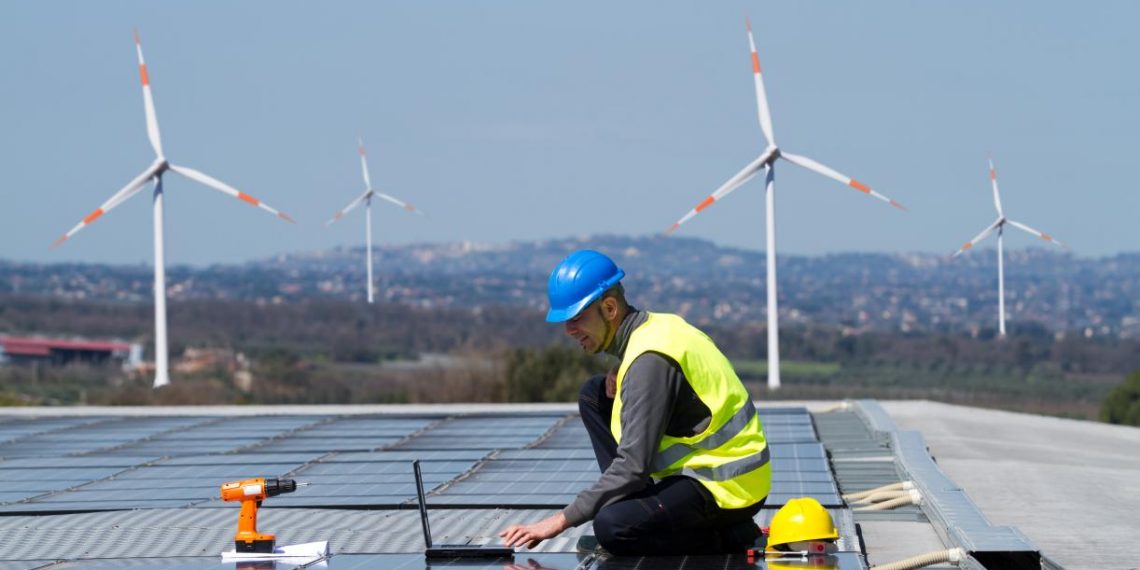Passive investing and sustainability are two of the most powerful trends in finance. They come together in the form of sustainable passive funds. But this rapidly growing sector, which has the potential to channel capital into vital climate investments, leaves something to be desired.
As opposed to active managers, passive fund managers do not try to pick stocks that will beat the market. Instead, they create a basket of funds that matches the market, or an index, or a sector. Because they are essentially on autopilot, passive funds typically offer very low fees. Their efficiency and low cost have made passive funds an investing strategy of choice in the United States, especially for people saving for retirement.
Passive funds, which were formerly dwarfed by active funds, counted $11.5 trillion total assets at the end of 2021 — $1.2 trillion more than U.S. active equity funds. More than $7.5 trillion of this sum is owned by U.S. defined-contribution retirement plans such as 401(k) plans and Individual Retirement Arrangements (IRAs).
Sustainability is a second megatrend in finance. As more investors understand the risks climate change poses to the planet, to businesses’ operating models and to their pocketbooks, asset managers are offering a profusion of sustainably marketed products. The most common approach involves “ESG” funds. “ESG” stands for “environmental, social and governance” data that investors can use to select companies that go into a financial product and improve risk-adjusted returns, for example by incorporating drought risk into the valuation of an agribusiness firm that has operations in an area affected by desertification.
Given the force of these trends, it is no surprise that passive sustainable funds are growing rapidly. In 2021, passive sustainable funds attracted a record $69 billion in net flows. Meanwhile the share of sustainable funds that were actively managed declined to 60% in 2021 from 81% in 2018.
This growth in passive funds with a sustainability focus is encouraging. But with questions of greenwashing – when funds marketed as sustainable or “green” mislead or do not live up to their promises – being raised, it is worth asking how the top passive sustainable funds fare against a widely recognized standard of excellence for climate-positive investing: alignment with the Paris Agreement.
Excitement Builds for ESG – and So Does Confusion
ESG investing is moving from niche to mainstream. Worldwide, money held in ESG mutual funds and ETFs rose globally by 53% last year to $2.7 trillion.
As is common in rapidly evolving and maturing market sectors, the growth and proliferation of ESG funds has raised questions. The asset management industry lacks a consistent set of standards or principles for sustainable investing, and some investors do not have confidence that ESG-labeled products are truly sustainable. Accusations of greenwashing pose a challenge to ESG credibility and progress. In May 2022, German police raided Deutsche Bank and its asset management group DWS over greenwashing allegations (specifically that ESG criteria were only taken into account in a minority of investments, not in a large number as claimed in the sales prospectuses of DWS funds). In the same month, the U.S. SEC charged BNY Mellon Investment Advisors for misstatements and omissions surrounding ESG considerations.
One potential path to creating greater transparency and confidence would be to take the world’s top goals for climate action, agreed to in Paris in 2015, as a lodestar and align finance with the goals of a just transition to a low-carbon, climate-resilient economy. Because the world’s nations are committed to these goals, they are an indication of the kinds of policies countries are likely to pursue – with major effects on which business models will succeed and thrive.
Assessing the Top Passive ESG Funds
Existing efforts to analyze investment funds against Paris Agreement goals typically exclusively focus on the headlined goal of cutting emissions so that we can limit global warming to 1.5 degrees C (2.7 degrees F) or 2 degrees C (3.6 degrees F). However, the Paris Agreement encompasses far more than just emissions reductions.
In a recent working paper, we developed a framework for Paris Agreement-aligned investing, which includes mitigation but also resilience, just transition and governance. We used this framework to analyze how the 35 largest, most popular U.S. sustainably labeled funds and funds aligned with the revised EU Benchmark Regulation for Paris alignment (EU PAB) perform.
Our analysis demonstrates that the opportunity to align with the Paris Agreement is far from being realized. Indeed, not one fund was fully aligned with our framework. Although EU PAB-labeled funds are the only funds in our sample that had Paris Agreement alignment as an investment objective, the lack of fully aligned funds illustrates that Paris Agreement-aligned criteria are not innately ingrained or assumed within most U.S. sustainable or ESG funds.
Here are some key findings on the specific areas in which passive sustainable funds fell short when measured against components of the Paris Agreement:
Emissions Reductions
To meet the Paris goals, we have to reduce greenhouse gas emissions, mostly by transitioning from fossil fuels to clean energy. A strong majority (25 of 35) of funds include some form of fossil fuel exclusion (i.e., they excluded certain companies from the fund due to their involvement with fossil fuels). At some funds the exclusion covered only companies involved with coal or tar sands while others excluded all companies that were part of the broader fossil fuel industry.
This indicates that carbon mitigation is on investors’ minds. However, only 17%, or 6 of 35 funds, incorporate any GHG emissions reduction targets – which target a reduction in absolute GHG emissions or emission intensities, usually annually – into investment objectives and portfolio construction. Moreover, some funds only use GHG intensity targets, which only guarantee efficiency gains – not absolute reductions in emissions.
Finally, burning fossil fuel isn’t the only source of carbon emissions. Most funds do not consider emissions from deforestation as a factor to avoid.
Resilience
Physical climate impacts surely threaten business, whether through the ravages of extreme weather like floods and heatwaves or through slower stressors like drought or sea level rise. But most of the funds we surveyed don’t adequately act on this threat. We looked at whether funds overweight companies that report on their resilience and/or companies deriving half or more of their revenue from climate-resilient solutions and found that twenty-one of the 35 funds did not do so, indicating that they did not consider climate resilience in fund composition.
Just Transition
No climate-focused fund (funds that focus on climate issues or climate-related sectors) integrates the concept of a just transition theme into its portfolio construction. That is to say, they don’t overweight companies whose practices and policies account for the distributional consequences of the transition to a low-carbon, resilient economy (Listen to WRI’s Big Ideas into Action Podcast: “What Is A Just Transition?”). Most of the ESG and social outcome-focused funds do consider social impacts of climate action (nine of 12) but with significant variance, Most of these funds exclude companies that have violated International Labour Organization standards, which may be relevant to a just transition.
All the fund types included in our analysis tend to exclude companies based on certain social metrics. Weapons and tobacco exclusions were most prevalent; however, few climate-focused funds incorporate exclusions for human rights violations.
Governance
According to KPMG, climate governance is the set of rules and processes a business undertakes to manage the risks and opportunities of climate change. But most of the funds we looked at do not consider climate governance and lobbying – as defined by the Climate Policy Engagement or Climate Governance indicators in Climate Action 100+ Net Zero Company Benchmark — in their weighting of companies. The indicators call, for example, for companies to ensure that any lobbying aligns with the Paris Agreement, and for executive renumeration to be linked to climate action. Not considering such governance dimensions is a clear oversight on the part of funds, at a time when lobbying activity has emerged as a blocker of climate action, and executives need near-term incentives to act.
How Do We Get There?
To make passive investing more coherent and powerful, several stakeholders must act.
Asset managers often argue that investment stewardship – or engagement between the fund and the companies it invests in – is a core component of maximizing long-term shareholder value and that this stewardship often considers ESG issues. But we found that tangible climate-related action is still rare. Despite asset managers labeling their products as related to sustainability, we found that only six out of the 21 managers managing the 35 funds (some managers oversee several funds) state in their stewardship policies or guidelines that they expect companies to align with climate change below a 1.5°C trajectory in alignment with the Paris Agreement.
Asset managers and index providers should provide greater transparency and better disclosures of their methodologies in prospectus and publicly accessible documents, as it is not currently clear how ESG factors are considered and weighted in the security selection process. U.S. asset managers and index providers should also work together to create funds that meet the Paris Agreement-alignment criteria.
Asset owners, including retirement plan administrators, should encourage asset managers and index providers to align with the Paris Agreement more closely. This will require asset owners to perform rigorous due diligence in selecting the index, the fund and the asset manager, since publicly available methodologies and stewardship policies may not provide sufficient information.
Not all the responsibility for making progress rests on the shoulders of fund managers or owners. A key barrier to developing Paris Agreement-aligned passive investment products is the gap in data availability and quality at the constituent company level. Without sufficient data on companies’ policies and performance against various climate-related criteria, it’s difficult to develop an index or product that aligns with the Paris Agreement. We believe that the rules on climate-related disclosures proposed by the United States’ SEC and regulators in other jurisdictions, such as the EU, will likely foster rapid change and improve disclosure of metrics and data.
Although passive investing cannot achieve a just transition to low-carbon and climate-resilience alone, it is a necessary condition for doing so. An increase in Paris Agreement-aligned investment products will indicate progress towards the goal of making all financial flows consistent with the Agreement’s goals for mitigation and adaptation and commitment to a just transition. Given the stakes, we need a drastic increase in the quality and size of Paris-aligned passive equity investing. A variety of actors in the investment community have a critical role to play in making this a reality.




